Be Our Guest: Tips For Hosting An Authentic Japanese Dinner Party
Get inspired to entertain Japanese-style thanks to "Tadaku — with locals."
Whether you're a local wanting some inspiration for your next dinner party or simply a visitor looking for a truly local experience, "Tadaku — with locals" is a wonderful chance to have a home experience and learn a few things along the way.
There’s no denying that Tokyo is a paradise for foodies. The city is often referred as the culinary capital and continues to boast the highest number of Michelin-starred restaurants in the world — a total of 230 compared with second-place Paris’ 118.
But having lived (and gloriously stuffed my face) in Japan’s capital for the last three years, there’s one food experience I miss from my home in L.A.
Dinner parties.
I really miss throwing dinner parties for friends and I miss going to them as well. There’s just something about being in the comfort of a home, relaxing, eating, and talking without feeling rushed like you sometimes can when eating out. For me, having an authentic home-cooked Japanese meal with local people can be an experience unmatched by any restaurant— however many Michelin stars it might have.
Experiencing “Tadaku — with locals”
Happily, I recently got the chance to experience a new service called “Tadaku — with locals,” a platform that offers both cooking classes and ready-made home dining experiences at Japanese homes.
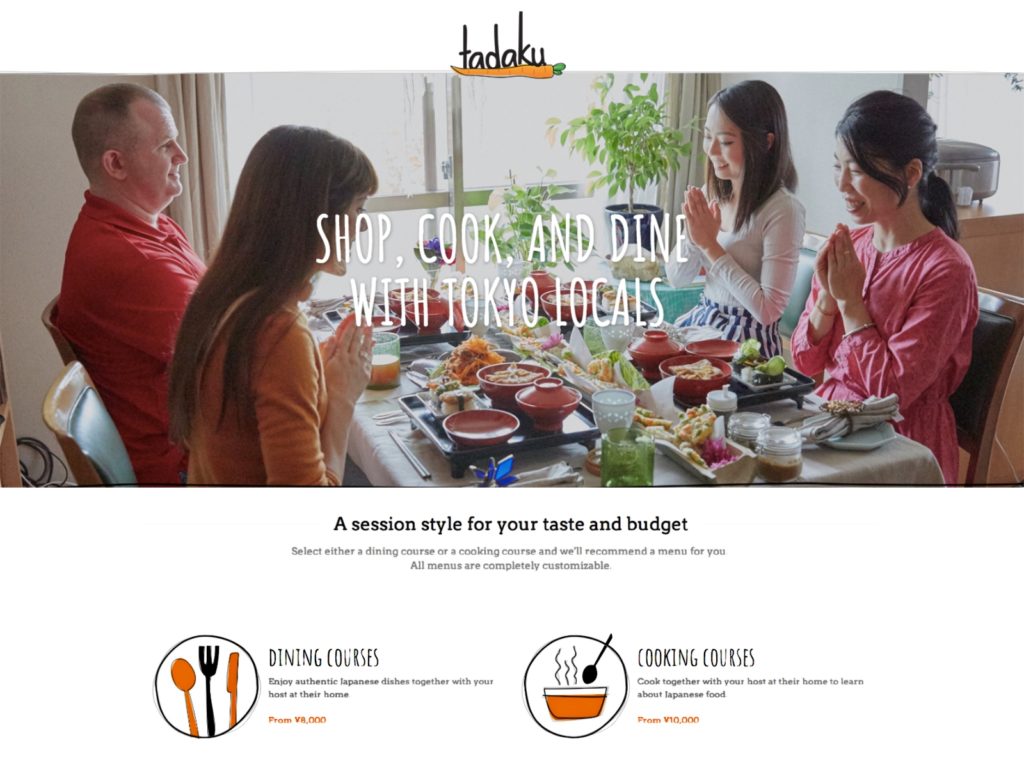
You can learn how to cook Japanese recipes or attend your own ready-made dinner party.
Both the cooking course and dinner party courses are run by a community of local foodies keen to share their expertise and love of Japanese food with foreign guests. Both also include casual and fancy options. The casual options include a random group of four to six guests while the fancy options are private.
Once you’ve picked the course, you have to fill out a detailed questionnaire allowing them to match you with the perfect host. They’ll ask a variety of things, including what kind of foods you want to try. You also get to mention your budget and what you are looking to get out of the experience to ensure you get exactly what you want.
My “Dining Course” experience
More eager to experience a Japanese dinner party than learn recipes, I chose the second option. One feature that really appealed to me about the service is that they choose a host according to your specific dietary preferences and restrictions, as well as other needs you disclose in the questionnaire.
As someone who values organic local produce, I was matched with Aya, a lovely lady who has experience cooking organic Japanese food and was also an experienced pastry chef.
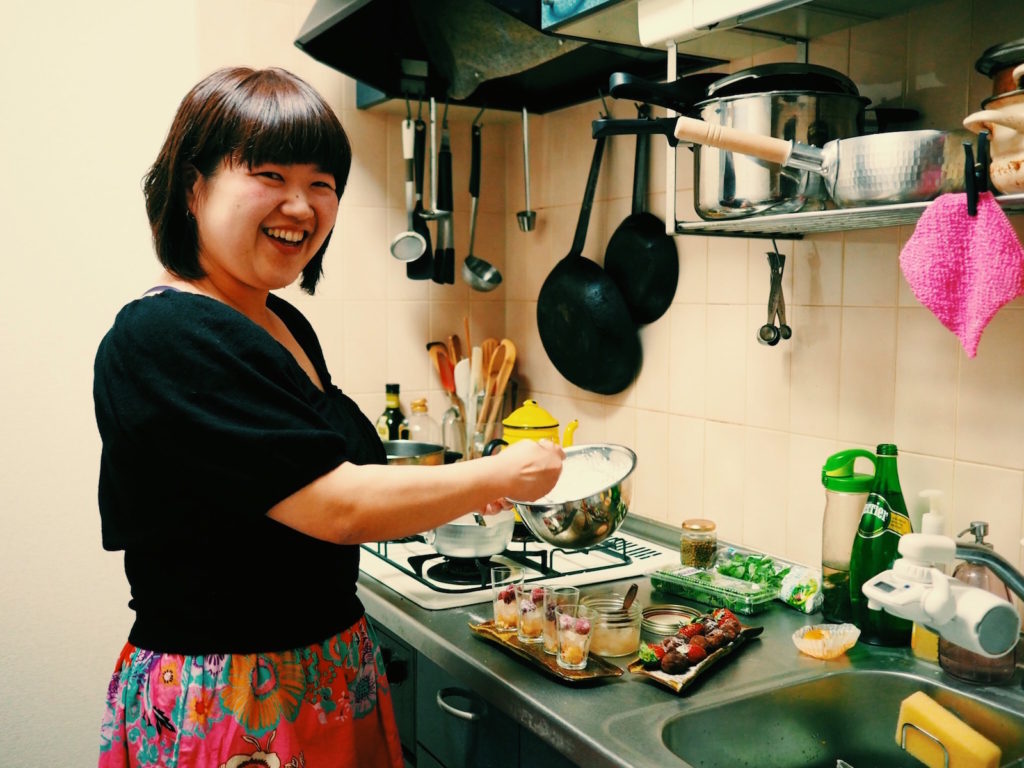
My lovely host Aya.
Aya had me over to her house for an incredible home-cooked meal during which she shared with me her personal tips and tricks for hosting a Japanese-style dinner party — and helped me to rediscover Japanese food culture at the same time.
Tip 1: The arrangement of food on the table is just as important as the food itself.
First things first, presentation is everything when it comes to Japanese food. Aya told me how traditionally, Japanese people present their foods carefully in select bowls and dishes, creating harmony between the ingredients of the meal and the plates they are served on.
Creating a beautifully set table is crucial in supporting the hard work that goes into making a meal. Japanese chefs typically take great pride in their dishware because it is believed that the shape, color and feel of the dishes can help enhance the overall experience.
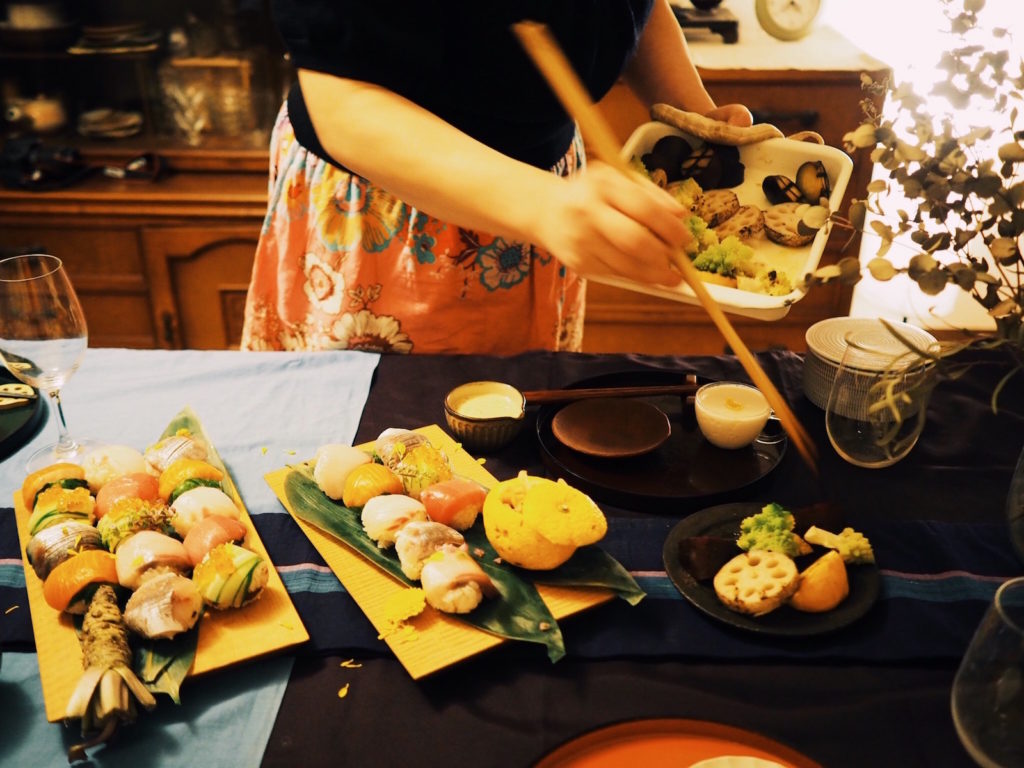
Aya made use of her impressive collection of beautiful dishware.
The aesthetics of Japanese table setting can include anything from ceramic plates, to red lacquer trays, to gold leaf chopstick rests, to natural bamboo sake cups. Aya used a lot of dishes with lids because they create an element of surprise when you open them.
Aya also told me how Japanese traditions are deeply tied to the seasons and in this way you can get creative when setting the table. For example, you can go outside and find something like a branch or flowers to use as garnishes or chopstick rests.
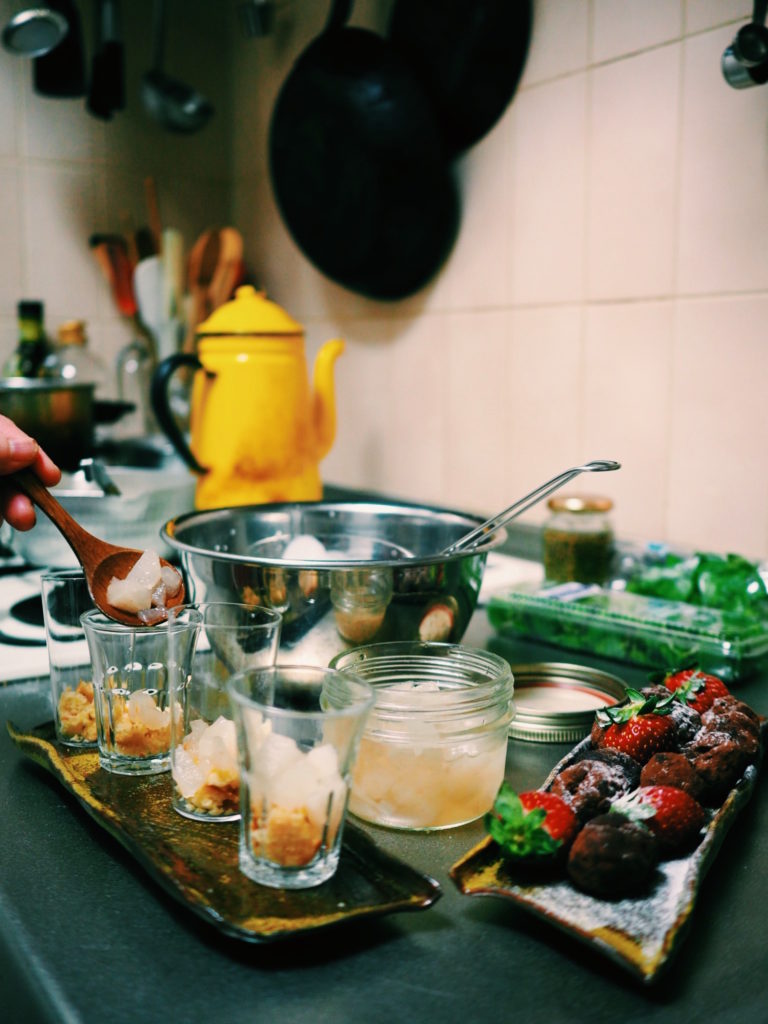
Aya used different sake cups and shot glasses to serve her dessert.
Another trick is to try to match the shape of the dish to the shape of the food. For example, using a long rectangular dish for fish.
Aya also explained that during all of her travels, she collects Japanese dishware so basically every dish has its own story. When I looked more closely, I realized that almost every dish on the table was a little bit different, but impressively enough, it all seemed to flow together in a zen sort of way. There were handmade ceramic dishes from Hokkaido, Okinawa and Hiroshima. The table runner was an old obi (kimono belt) and the dining table itself had been passed down to Aya from her grandmother.
Tip 2: Source seasonal ingredients and know how to keep it simple.
Simple and seasonal are two key factors when it comes to Japanese cooking. Most of the dishes served were only about three to five ingredients and relied heavily on seasonal ingredients. Aya told us that using ingredients that are in season helps illustrate the flavors as true representations of how mother nature intended them to taste.
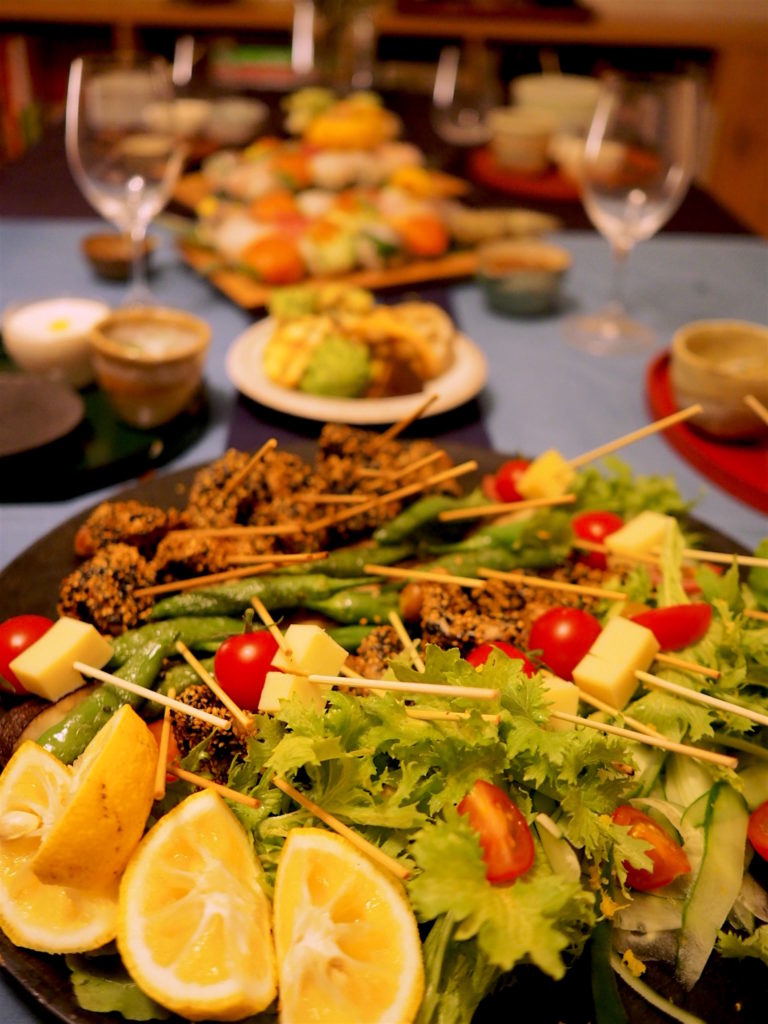
In-season yuzu was a motif throughout the meal.
The appetizers consisted of dashimaki tamago (Japanese omelette with fish stock), shungiku no ohitashi (chrysanthemum leaves with sesame sauce), a fried taro ball and brie cheese skewer, and strips of daikon (radish) marinated in a homemade plum vinegar. Homemade tofu with a gorgeous ricotta-like texture followed — the tiny yuzu skin placed on top adding a punch of flavor.
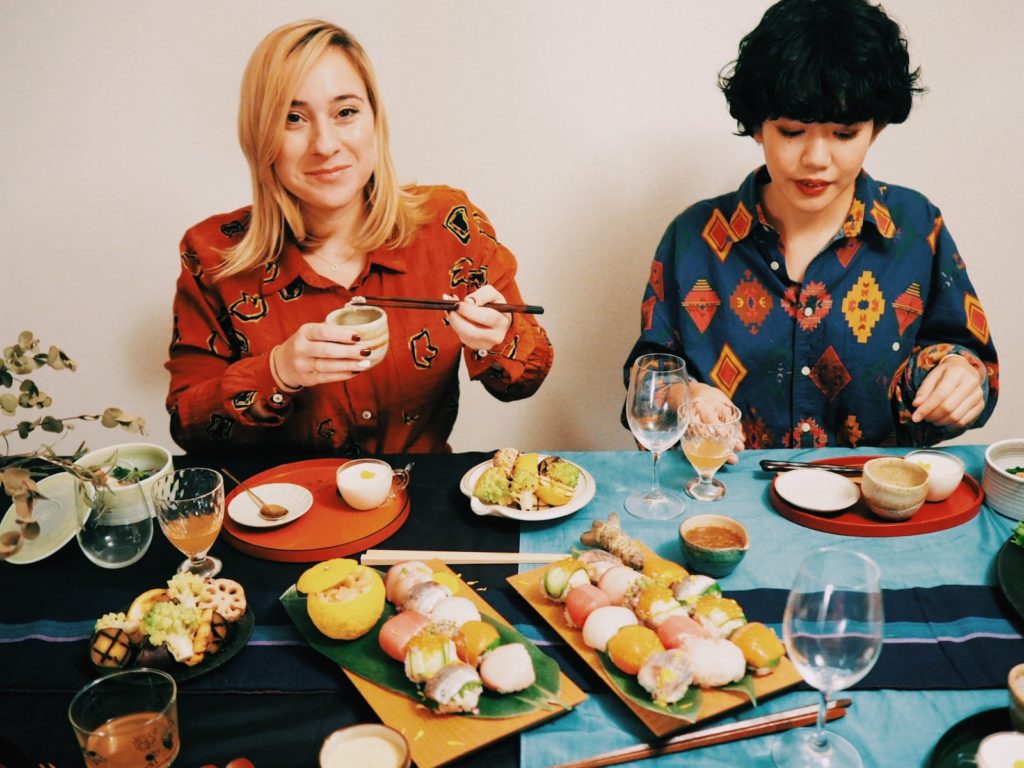
Me and another guest, Kira, enjoying Aya’s delicious appetizers.
The next course was a fun party pleaser — meat, veggies, and cheese on a stick. To garnish the skewers, Aya lined the dish with crisp mustard greens and arugula seasoned with yuzu zest. For the final course, we enjoyed simple grilled vegetables and sushi balls (called temari) including fatty tuna, sea bream and cucumber with shiso flowers.
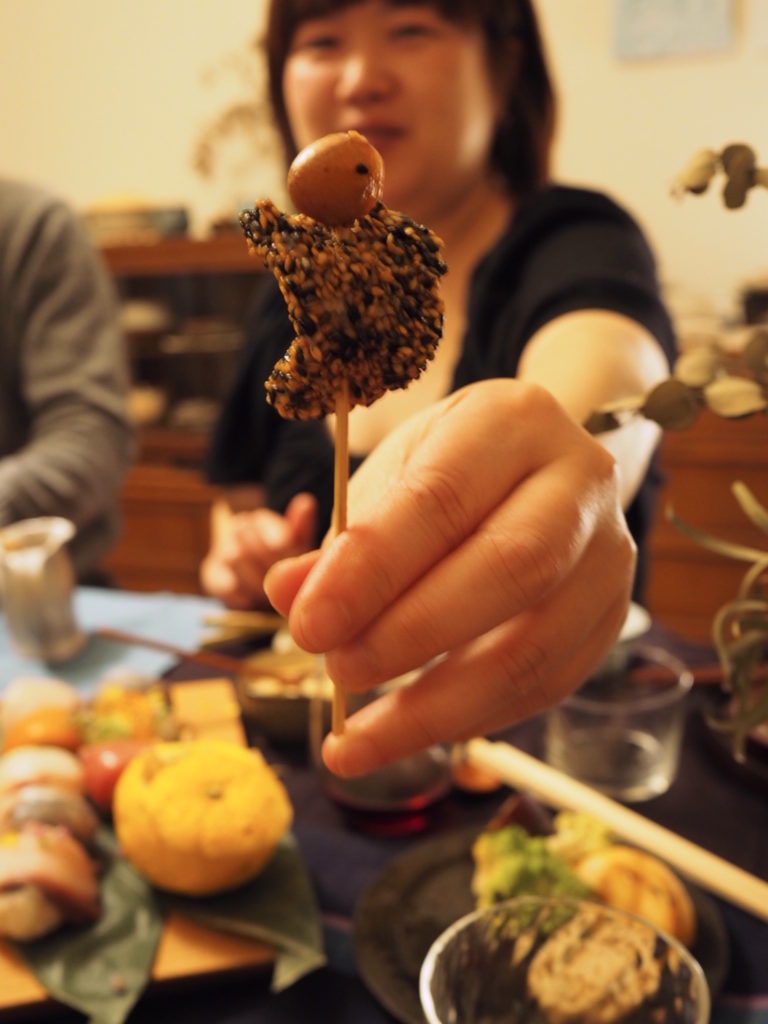
Simple but tasty.
Dessert was a delectable platter of chocolate cake bites which had caramelized apples and raisins inside of them along with fresh strawberries. She also brought out mini Japanese parfait cups filled with homemade yuzu cake and Japanese pear compote soaked in sake and yuzu.
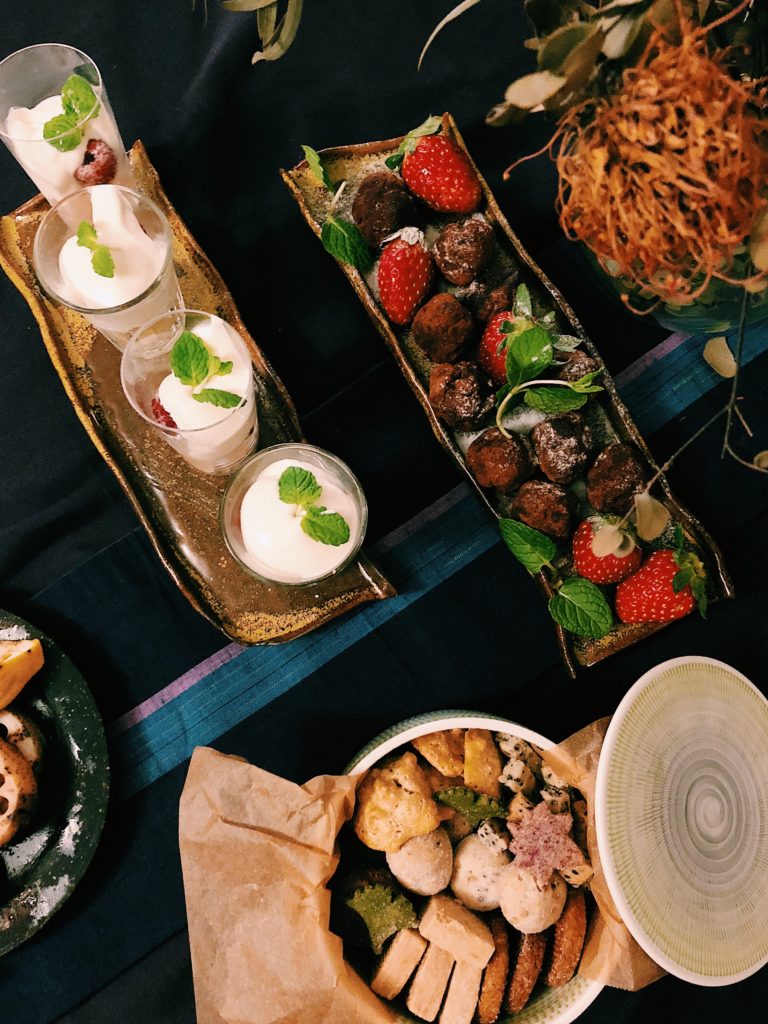
If all that wasn’t enough, she even brought out a box of homemade cookies to rival my own mothers (sorry mom!)
Tip 3: Use what’s available at your local Japanese market to inspire your menu and make your prep work more efficient.
Aya had scoured her local market a couple days prior to the dinner party in order to brainstorm different dishes she could make with what’s in season. She also used a delivery service that delivers organic produce which I think is a great idea that can save a lot of time.
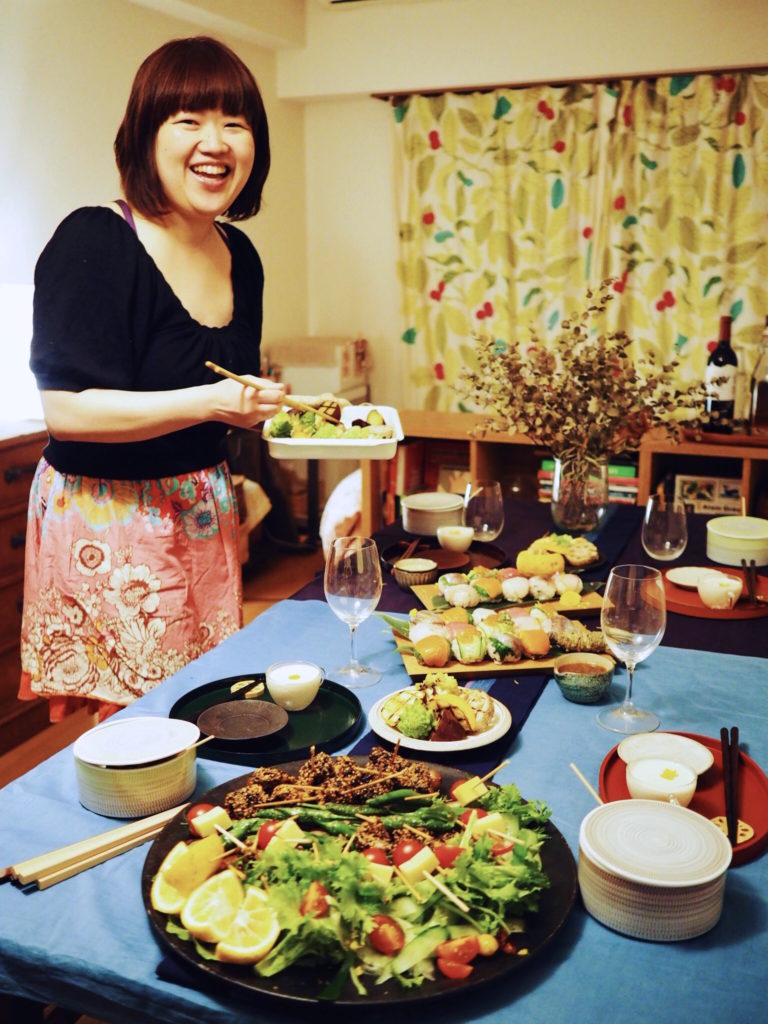
Aya had prepped a lot of things in advance so she could sit down and enjoy the meal with us.
Aya made her own dipping sauces ahead of time, as well as the desserts. On the day of the dinner party, Aya cooked the main courses and had it ready to go on the table when guests arrived so she was able to sit down and enjoy socializing with her guests, rather than waiting on them during the party itself.
Aya also advised to set the table a day before as well. As well as Japanese ceramics for tableware, she said that you can use any old kimono or yukata as a tablecloth. But if like me you’re not prone to having loads of those lying around, another popular tradition is indigo-dyed cloth.
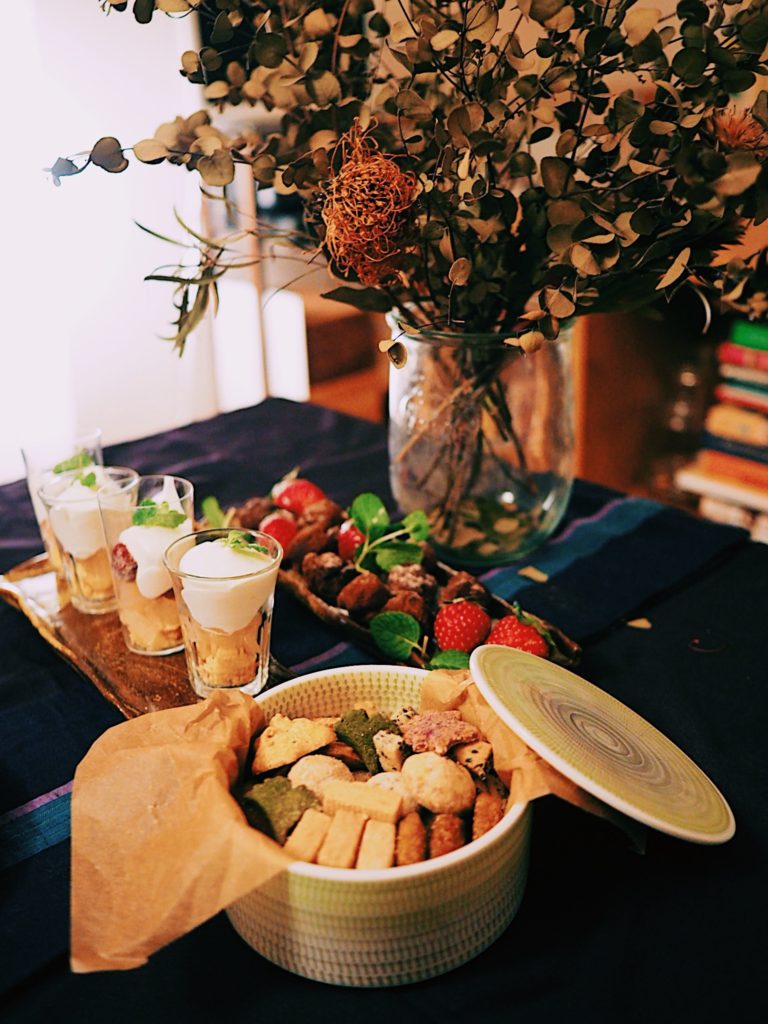
Aya’s gorgeous desserts next to her flower arrangement.
Lastly, buying fresh flowers is always a beautiful choice, but Aya had a classic dried flower arrangement to compliment her more traditional style. She also suggested going outside and picking something pretty if you can (weeds need not apply).
Now — your turn
From using old kimono belts as a table runner to hollowing out a yuzu fruit and using it as a vessel for pickled ginger, Aya really showed me how to get crafty at my own dinner party and I can’t wait to try out her tips for myself.
But more than anything, having dinner at Aya’s was just such a lovely way to spend a late afternoon re-immersing myself in Japanese food culture again.

Cheers!
If you’re a tourist or even a newbie to Tokyo who hasn’t had the opportunity to experience a traditional Japanese dinner in someone’s home, then Tadaku is also a great service to consider. You do really get a deep look into a locals home and a chance to see just how a Japanese kitchen really works.
Plus you get to eat. And who doesn’t enjoy that?!
The Deets
Browse through the various menus and hosts at: https://locals.tadaku.com. Once you find something you like, fill out your preferences in the request form and Tadaku will get back to you regarding your booking.
Dining courses start at ¥8,000 and cooking courses start at ¥10,000.
Savvy Tokyo X Tadaku – with locals Giveaway!
Want to experience Tadaku — with locals for you and your friends? You could win a FREE private cooking class or dinner party experience in Tokyo for a group of up to four people! All you have to do is fill out the form below with your email, availability and menu preferences.
Even if you aren’t picked as a winner this time, every person who fills out the form will be given a ¥500 coupon to spend on any future Tadaku — with locals experience. Just enter the code SAVVY2019 in the “Campaign Code” box on the request form on their website when you book.
Fill out the form below for a chance to win!
If you’re having trouble seeing the form on this page, please go to this link.
Terms & Conditions
- The giveaway is open to both residents and tourists able to attend an experience within Tokyo Prefecture or Kanagawa Prefecture. You are responsible for your own transport to and from the venue.
- The winner must be able to attend an experience anytime before the end of September, 2019.
- The cooking class or dinner party will be a private experience for you and your group (up to 4).
- Winners will be notified directly by Tadaku — with locals in the first week of March.
- The cooking class or dinner party can be conducted in English or Japanese. There are some hosts who can speak other languages (such as Spanish, Italian and Chinese). Please ask when you make your booking.
- Tadaku — with locals may use your email address to send you information on their services.




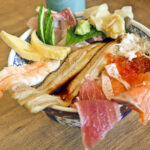







Leave a Reply